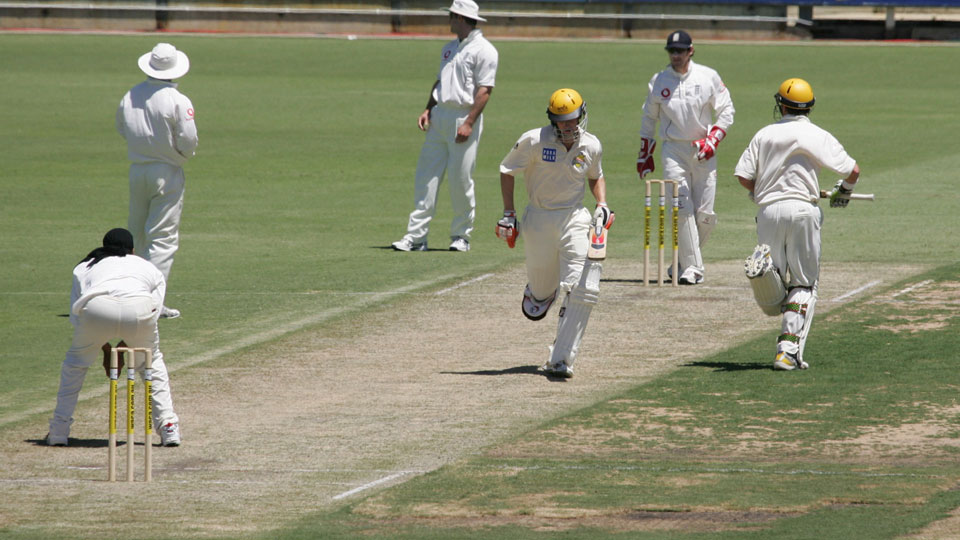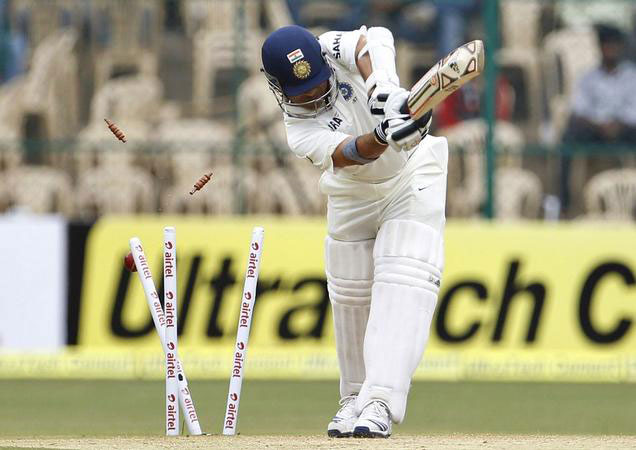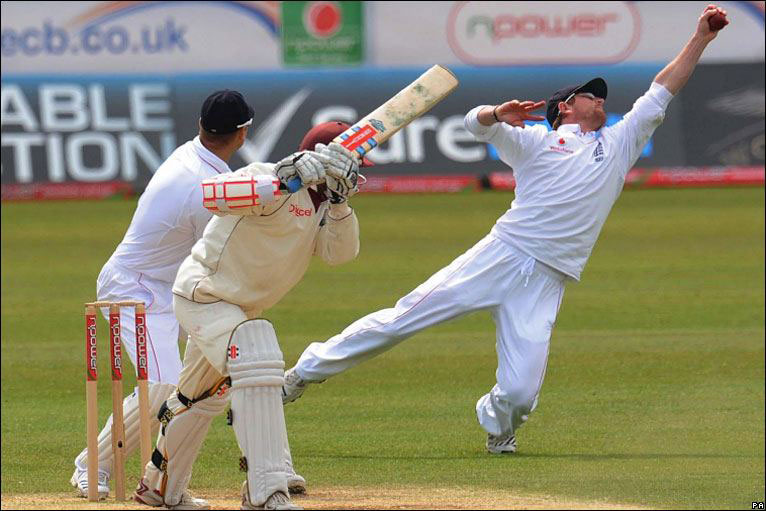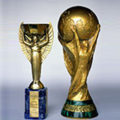The game and the field
Cricket is a bat and ball game played between two teams of 11 players on a large round field.
In the centre of the field is a rectangular pitch (20m long) where the bowling and batting action takes place.
- Melbourne Cricket Ground in Australia
Like baseball, one team ‘bats’ while the other team ‘fields’.
However, in cricket the batting team bat in pairs, and they continue batting until 10 of the 11 team members are ‘out’.
The fielding team must continue fielding until 10 of the batting team are ‘out’ (i.e. there is only one batter left – no pair).
A game of cricket is divided into ‘Overs’ and ‘Innings’. One ‘over’ is made up of 6 balls. After 6 balls have been bowled, the bowler must change. Anyone on the fielding team can bowl, but most teams usually have 4 or 5 specialist bowlers and 5 or 6 specialist batsmen.
Scoring runs
The batting team must score as many ‘runs’ as possible, by hitting the ball and running to the other end of the pitch. If the batsman can reach the other end of the pitch successfully, he scores 1 ‘run’. If he can reach the other end of the pitch and return, he scores 2 runs etc.
If he hits the ball to the edge of the field, he scores 4 runs. If he can hit the ball to the edge of the field without bouncing, he scores 6 runs.
The batsman can continue to bat until he is ‘out’ – and then he will be replaced by his next teammate.
Sometimes the first batsman is never out, and he scores 100 or 200+ runs in the game.
- 2 batsmen running after hitting the ball
Bowling
There are many different kinds of bowlers; some bowl very fast, and some bowl slower but spin the ball. One very important rule for all bowlers is that the ball must bounce once before reaching the batsman.
This is obviously very different to baseball, where the ball doesn’t bounce between pitcher and hitter.
- A fast bowler’s bowling action
Cricket is a very tactical game. The fielding team captain will change the positions of his fielders depending on the type of bowler or the type of batsman.
How to be ‘out’
The batsmen can be out in many different ways. For example:
1) Caught: He hits the ball and a fielder catches it.
2) Bowled: The bowler bowls the ball and hits the batsman’s ‘stumps’.
3) LBW (Leg before wicket): The bowler bowls the ball and hits the batsman’s legs – which block the ball hitting the ’stumps’.
4) Run out: The batsmen try to run, but the fielding team throw the ball and hit the stumps before the batsman is safe.
5) Hit wicket: The batsman hits his own stumps with his body, equipment, or clothing.
- Bowled!
- Caught!
Types of cricket
Some games of cricket have 1 inning per team, and the team who scores the most runs is the winner.
Some forms of cricket have 2 innings per team, and the winning team is the team that scores the most runs in total.
There are 3 types of cricket game.
The shortest and fastest game is called ‘Twenty 20’, and lasts 20 overs per team. A full game usually takes about 2.5 hours.
The medium length game is called a ‘One-day game’, and lasts for 50 overs per team.
The longest length game is called a ‘Test Match’, and lasts for a maximum of 5 days. (2 innings per team).
A ‘Test Match’ usually starts at 11:00am and finishes at 18:00pm, with a 40 minute lunch break at 13:00, and 20 minute tea break at 15:40. 90 overs are expected to be bowled during the day’s play.
Some interesting facts about cricket
Cricket is played by more than 120 million players in many countries which makes it the world’s second most popular sport.
It was first played in England in the 16th century.
As the British Empire expanded, cricket was introduced to more countries.
By the mid 1850s, international games were being played.
Cricket is most popular in England, Australia, India, South Africa, the West Indies, New Zealand, Pakistan, and Sri Lanka.
Recently countries such as Bangladesh, Zimbabwe, Kenya, Ireland, Afghanistan, Netherlands, and Canada have become more successful as the sport becomes more popular.








